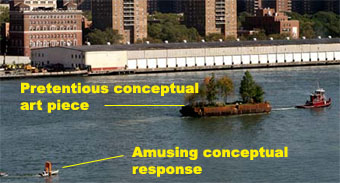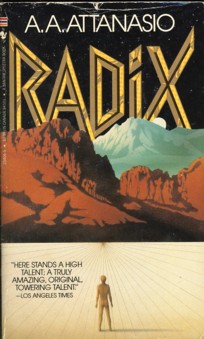View current page
...more recent posts
In case you haven't seen the love letter Scooter ("Biff") Libby wrote to Judith ("Queen of All Iraq") Miller, here's the last paragraph. The typographical equivalent of vomiting will follow. Here's what one mass killler (and published novelist) says to another mass killer (with a book deal):
You went to jail in the summer. It is fall now. You have stories to cover--Iraqi elections and suicide bombers, biological threats and the Iranian nuclear program. Out West, where you vacation, the aspens will be turning. They turn in clusters, because their roots connect them. Come back to work--and life. Until then, you will remain in my thoughts and prayers. With admiration, Scooter Libby.This is childish, but bleeeeaaaaagggghhhhh. Wasn't Saddam Hussein also supposed to be some kind of novelist? Here's hoping Biff goes to the Big House, just for writing that paragraph. Jane Hamsher, posting on Digby's blog, has more on what sort of coded info was being communicated in the non-mash-note part of the letter. Haven't been following the Plamegate minutiae to this extent, but it's pretty clear that navigating the twists and turns of the investigation is how we're processing the terrible crime of the Iraq war, because the Democrats are too complicit to have a real debate about it. The aspens can't turn soon enough for me.

This photo cartoon, from Gawker by way of Forward Retreat, depicts an actual event. The big boat is re-enacting an artwork that was never enacted, Robert Smithson's "Floating Island," while the little boat tugs a Christo orange gate--a cheeky student project. Didn't see the actual tree-barge, just the photos, and while it looks entertaining, should it really have Smithson's name attached to it? If the artist were alive, he might well have moved on from this kind of eco-showmanship. Who the hell knows? It's a bit like August Derleth writing novels in the style of H. P. Lovecraft, tres postmodern but perhaps an empty exercise. The theme of disembodied, portable nature arguably achieved its apotheosis in the movie Silent Running, made in '71 (with a fantastic folk-modern score by Peter Schickele, that helped set the mood). Recalling (anticipating?) not-Smithson's tugboat, Bruce Dern's spaceship the Valley Forge contains the last remaining earth forests, floating in sealed domes out near Saturn. The shitty earthlings, who live on food substitutes and remarkably still seem to have an atmosphere despite the absence of plant life, order Dern to "blow the domes" with nuclear explosives.
Couldn't finish this book myself, but the writing is poetic and transporting. Just ordered another copy to try again. Suddenly having an '80s moment, thinking about unread books on the floor next to my bed back in the day. From amazon, an unfortunately "red" company that happens to be a place A. A. Attanasio fans can meet and greet:
 Overlooked masterpiece..., August 3, 2003
Overlooked masterpiece..., August 3, 2003Reviewer: A reader
[...] a real mind blower with a slipstreamy feel to it at times, hard SF at others, and an occasional hint of some New Age elements.
On a future Earth where the planet has crossed paths with a beam of intense radiation from deep space (and which seems to have brought an alien influence to humanity in the form of genetic mutations), an angst ridden teenager named Sumner Kagan has taken to calling himself the "Ziggurat" [actually it's the "Sugarat" --ed.], and begins to take out his frustrations, vigilante style, on the gangs who menace the remnants of humanity.
And as the posessor of a "white card", testifying to his clean set of genetics in this society of mutations, Sumner is allowed to breed with what are roughly the equivalent of government sponsored prostitutes. But his physical appearance (he's overweight, acne ridden and a total slob) repulses the prostitutes whose function it is to save his genetic material.
Unable to find his place in life, Sumner begins a relationship with one of the alienistic mutants, called a Voor, and soon after must flee into the hellish wastelands that are all that remain of Earth after the encounter with the beam. During his journey and the trials that come with it, Sumner begins to gain insight into what he is and discovers powers that he may not be able to control.
Although Attanasio's SF novels are largely out of print, and that doesn't appear to be changing anytime soon (what a shame...), do yourself a favor and find a tattered copy of this book...
One of the most frustrating and annoying SF books I've read, March 16, 2002
Reviewer: A reader
[...] It started out all right, with the protagonist Sumner Kagan gaining revenge against various gangs. Although it didn't hook me, it was enough to keep me reading. But once the novel introduced the voors, telepathic entities, it started going downhill into an endless stream of metaphysical mumbo-jumbo. The plot, if it could be called such, veered off into a hundred different directions and I couldn't buy Sumner's development from fat, picked-on punk kid to Nietzchean superman. The novel might have been better if it just stuck to the pre-developed Sumner. And the climax and ending were so scattershot and confusing, I felt like I was reading Mad Max meets Monty Python meets Nietzche. Half the time I didn't understand what was going on. And when I did, it didn't interest me.
Reading this book was also an exercise in frustration, as a hundred different characters keep popping in and out. You need a score card to keep track. And terms. He sticks together so many words and phrases and similes that my eyes glazed over trying to read them. Psynergy, eo, Delph, godmind, voors, starglass. It's annoying to have to go back and forth trying to figure who's who and what's what. The only reason I even finished this book was because I had already read half of it and wanted to see if it got any better.
Reviewer: AndyC (Canberra, Australia)
I am glad that I read the later, harder-SF "Centuries" before "Radix". Attanasio operates well as either a hard SF writer or as a metaphysical fantasist. In this, his first book, he tries to be both at once and it doesn't quite work. "Radix" is a saga of a far-future Earth in which mutation has gone rampant after a cosmological cataclysm. Daringly, lead character Sumner Kagan starts off as a screwed-up, homicidal, obese urban teenager. Through the several hundred pages, he transforms into a battered-but-charismatic hero and troubled demigod. Kagan, the divers supporting characters and some of the Big Ideas are great: I was satisfyingly creeped out by the concept of a powerful AI spying on the world through the senses of millions of synthetic "wild animals". However, the highly metaphysical treatment of the nature of one of the species, and of "life force" generally leaves something to be desired, the "Love Reigns Supreme" moral is a tad heavy-handed, and the pseudoscientific rationalisations that appear here and there are bogus enough to break belief for any reader with any scientific nous. Then there is the writing style. Later Attanasio is lyrical and reads beautifully and easily. Here, he overdoes it. Some sentences are elliptical to the point of incoherence. Pretentiously florid adjectives are piled on top of hopelessly inappropriate metaphors. The overall effect is a bit like "Covenant"-era Stephen Donaldson trying to write a Greg Bear novel by channeling acidheads from Zeta Reticuli. [...]
Extremely original; stark but inspiring!, May 27, 1999
Reviewer: lewcas (Long Island, NY)
What I wouldn't give for more of the centuries-long backstory of RADIX! The idea of Earth precessing into a Line of exotic radiation from the galactic center, and being forever altered is one of those incredibly elegant, simple ideas that I would KILL to have thought of myself! What a great premise! Once you've got an idea that great, it must be so much easier to write something wonderful.
I am SO curious about this A.A.Attanasio person! I've seen other reviewers here refer to this author as "she" [...] I picked up Attanasio's very next book and was VASTLY disappointed. Something boring set in Hawaii, as I recall, and it certainly didn't have anything to do with RADIX, far as I could tell.
A.A is a guy, July 17, 2000
Reviewer: jonnythegimp
Lives in Hawaii himself. Just letting you all know. I loved this book i am just trying to find it again.
Transparent and inflexible center of the diamond of time, September 24, 1999
Reviewer: Douglas L. Jones (BLOOMINGTON, MN United States)
The "A.A" stands for Alfred Angelo, so I don't think it's a female. I love this book. His wonderful use of language alone is just amazing. I've never read anything remotely like it.
Update: I originally said amazon was the "only" place Attanasio fans could gather: d'oh, he has a website.
Update 2, January 3, '06: Read this book and don't know why I couldn't finish it in the '80s. It really is a perfect combination of Bruce Sterling-esque post-human sci fi and Carlos Castaneda mysticism. I've also since read several other of Attanasio's sf books. He is a hell of a writer and a true visionary who isn't afraid to stick close to pulp roots.
"Glitch Western" [mp3 removed]. I'm actually not much of a fan of so-called glitchcore, unless it were to have, say, a doomy, latinate, faux-western soundtrack overlay ending in an anthemic house thump.

Working on presentation of these wormy vortex drawings. The physical, printing-and-display part is boring. Most of these are test prints, eventually they'll all be on Epson's 100% rag paper, which is a neutral surface, surprisingly not arty-looking at all. And framed like the pieces cropped at the top and bottom of the photo. (Computer work done in an ordinary program like MSPaint or Paintbrush becomes more problematic when you treat it like a sacred museum object, I swear it's not just for retail reasons. Evidence of a certain financial commitment to what's perceived to be cultural ephemera. Plus they just look more embodied, and therefore more interesting in person.) After printing a couple I noticed the inked outlines were mushy--not crisp like they're supposed to be. Was it the ink bleeding into the rag paper? No, my new-ish printer defaults to "edge smoothing." I can't believe I just realized this. Drawings done in pixel-y programs should have sharply pixeled edges, so they look like what's on the screen. Edge smoothing gives everything that "resampled in Photoshop" look--ugh. Not acceptable.
"93 in the House" [mp3 removed]. This is a straight-up, old school house tune I've been working for a few days. The basses and pads are familiar sounds of yesteryear but the rhythms use fairly up to date digital methods, such as NI's "spektral delay," which spectrally analyzes the beat and rearranges it to create echoes with varying attack curves. The drums mix samples and live synthesis. The tunes I wrote, trying to stay "in period." Those who may have followed these music posts of the past year will note the first use of a bridge and two dropouts.
Here are eight of the "25 Questions Regarding the Murder of New Orleans" currently posed online in The Nation by Mike Davis and Anthony Fontenat. The locals they interviewed are certainly asking these even if the rest of us aren't. To tweak the line from the '60s, "just because you're paranoid doesn't mean people aren't trying to kill you and steal your land." Some straightforward answers now could stanch conspiracy theories later on:
1. Why did the floodwalls along the 17th Street Canal only break on the New Orleans side and not on the Metairie side? Was this the result of neglect and poor maintenance by New Orleans authorities?
2. Who owned the huge barge that was catapulted through the wall of the Industrial Canal, killing hundreds in the Lower Ninth Ward--the most deadly hit-and-run accident in US history?
3. All of New Orleans and St. Bernard Parish east of the Industrial Canal were drowned, except for the Almonaster-Michoud Industrial District along Chef Menteur Highway. Why was industrial land apparently protected by stronger levees than nearby residential neighborhoods?
9. Why were the more than 350 buses of the New Orleans Regional Transportation Authority--eventually flooded where they were parked--not mobilized to evacuate infirm, poor and car-less residents?
10. What significance attaches to the fact that the chair of the Transportation Authority, appointed by Mayor Nagin, is Jimmy Reiss, the wealthy leader of the New Orleans Business Council, which has long advocated a thorough redevelopment of (and cleanup of crime in) the city?
11. Under what authority did Mayor Nagin meet confidentially in Dallas with the "forty thieves"--white business leaders led by Reiss--reportedly to discuss the triaging of poorer black areas and a corporate-led master plan for rebuilding the city?
19. Is the Justice Department investigating the Jim Crow-like response of the suburban Gretna police, who turned back hundreds of desperate New Orleans citizens trying to walk across the Mississippi River Bridge--an image reminiscent of Selma in 1965?
20. Who is responsible for the suspicious fires that have swept the city? Why have so many fires occurred in blue-collar areas that have long been targets of proposed gentrification, such as the Section 8 homes on Constance Street in the Lower Garden District or the wharfs along the river in Bywater?
[via]
Just returned from 23 REASONS TO SPARE NEW YORK: MUSIC VIDEOS FROM THE ART ROCK SCENE at Galapagos, an entertaining* mix by Nick Hallett of the commercial and the non-commercial, the brain-pounding (Black Dice/Danny Perez) and the charming (Regina Spektor/Adria Petty), with an eye for stop motion, '70s blue-screen montage, and exquisitely awful found footage (thinking of Quentin Tarantino in Kent Lambert's "The Biggest Night in Music," a splendid example of how success is not good for certain people). A quick look around the Net found several of the vids online (see below). Based on audience reaction "Relax with Kenny G"--the jazz lite saxophonist, not the WFMU dj--stole the first show, certainly getting the most laughs. Pictures of the long-tressed schlockhound are almost inherently funny. Also great were Antony and the Johnsons (haunting vocals accompanied by Glen Fogel's obsessive cropped lensing of a diva luxuriating/writhing in agony on a bed); "Heavy Metal Baghdad" (Iraqi rockers complaining about the lack of electricity), the punishing psychedelia of Roentgen's/Devin Flynn's "Cat Loop" (intense analog flanging meets Felix the Cat fractals), and Mixel Pixel's/Noah Lyon's "Telltale Drum Machine" (high speed video graffiti).
From around the Net:
Foetus: "Blessed Evening," dir. Karen O, 2005, 4 minutes (Director of Photography Spike Jonze). Foetus looks like Kim Fowley, at least in this video-severed-head mode.
Out Hud: "It's For You," dir. The Wilderness (cute/creepy stop motion)
My Robot Friend with Bingo Gazingo: "Kenny G.," dir. My Robot Friend (what does WFMU Station Manager Ken mean about "releasing Bingo Gazingo from his contract"? Did he misbehave on the air?)
Jason Forrest: "Steppin' Off," dir. Jon Watts/Waverly Films (the one with the LARPing theme--you gotta love that wizard)
*I can't properly review the show because one of the 23 reasons was mine but believe I can say the mix was entertaining.
